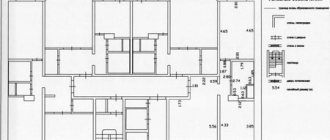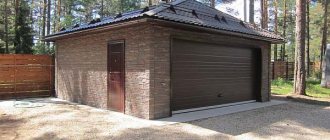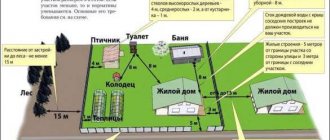Before building a house on your private property, you need to take into account several factors, among which, first of all, is the location of the structure. As a rule, every owner of a plot wants to build a house that is comfortable for living. Here you need to adhere to acceptable standards - correctly calculate the layout, size of the building and the location on the site where the house will be built. These permissible norms prescribed by law are provided not only for the comfortable living of the owner of the site, but also for the convenience of neighbors. But in some cases, when constructing a building, a number of mistakes are made that require special attention - one of them is building a house close to the fence. This happens when not all the details in the correct layout are taken into account, as well as the dimensions and length of the main staircase. In order to prevent such a mistake, before laying the foundation it is necessary to take careful measurements - the extreme point from the fence to the building should be at least three meters. But there are cases when neighbors made incorrect calculations regarding the land plot or simply decided to bypass all existing standards and built their house close to the fence. Therefore, many, faced with this problem, are wondering - a neighbor built a house close to the fence - what to do and where to go?
Neighborhood disputes
In this situation, you should not go into conflict, as this will not lead to anything good. In addition, filing an application with the court is nothing more than additional expenses. It is best to resolve such issues before a conflict situation arises. Three points of instructions:
- Variation of fencing structures on the site;
- Rules for the location of main structures, planting trees and shrubs regarding the border of the site;
- Resolving conflict situations.
Making compromises is a good solution in many controversial situations. But you shouldn’t relax, as you need to be ready for any action.
Norms for delimiting a land plot
In order to avoid neighbor wars, you need to familiarize yourself with the existing norms. But here, too, everything depends on certain circumstances, which are characterized by various factors. One neighbor built a house before another, then it is important for the second neighbor to know about the concept of fire distance. This is the safe distance at which houses should be located from each other. If the second neighbor is building a house of stone, then the distance between the houses should be at least 6 meters. A house built of stone and wood should be located at a distance of 10 meters from another house. If two houses are made of wood, then the distance should be at least 15 meters.
About the boundaries of neighboring houses
In accordance with clause 7.1 of SNiPa 2.07.01-89 and clause 5.3.4SP 30-102-99 in areas of estate and garden-dacha development, the distance from the windows of residential premises (rooms, kitchens and verandas) to the walls of the house and outbuildings ( barn, garage, bathhouse) located on adjacent land plots must be at least 6 m, and the distance to the barn for keeping livestock and poultry - in accordance with 8.6 of these standards. The distance from the boundary of the site must be at least: to the wall of a residential building - 3 m; to outbuildings - 1 m. In the absence of a centralized sewerage system, the distance from the toilet to the walls of the neighboring house must be taken at least 12 m, to the water supply source (well) - at least 25 m.
This is interesting: Nsdi has property, is it possible to enroll in the young family program?
The distance from the house to the fence must be no less than those established by the following standards: SNiP 2.07.01-89 “Urban planning. Planning and development of urban and rural settlements", SNiP 31-02-2001 "Single-apartment residential houses", SP 30-102-99 "Planning and development of areas of low-rise housing construction", SNiP 30-02-97 "Planning and development of gardening areas ( dacha) citizens’ associations, buildings and structures.”
How might the situation threaten you if your neighbor built a house close to the fence?
- If one neighbor built a house close to the fence, then his windows may be opposite the windows of the second neighbor, which will cause some housing discomfort.
- During rain, runoff water can fall on the second neighbor's building, which will negatively affect the entire building.
- Closely built houses create shade between them. In this case, the possibility of any plantings is practically excluded. This also has a negative impact on the building itself, because the side that is always in the shade does not dry out well, especially if sewage gets on it during rain.
- If the first neighbor built a house close to the line of a fence that does not yet exist or on the boundary itself, and then wanted to build a fence, then the second neighbor loses a significant part of his plot.
The construction of a private house on a boundary is possible if one of the neighbors has given a written agreement to this effect.
Resolving controversial issues
As you know, the construction of a residential building is a long process. If the first neighbor is just starting to build a house that will be located close to the fence, then you should act immediately. Since it will be much easier to make adjustments to the construction plan in the early stages, but when the house is already built, it is almost impossible to do this. As a result, the second neighbor will not only have his rights infringed, but also the level of comfort on his own private territory will decrease. If the building is located close to the fence and no written permission was given for this, then the plan for such a structure was not carried out correctly.
In such a situation, it is necessary to find out whether any of the owners of the private plot gave written permission. It is also possible that one of the co-owners could have previously given verbal permission. But such permission has no legal force and the neighbor who built the house close to the fence will still have to compensate the injured party if:
- A cadastral passport has been received;
- Property rights are registered;
- There is a plan for demarcating a private plot.
If there are no such documents, then the neighbor who built the house close to the fence can initiate the distribution of the land plot in his direction.
Otherwise, the injured party will lose part of their private territory. It will be pointless to resolve the issue in court, since the court will side with the neighbor who built the house close to the fence and will award one meter in his favor, taking into account the repair of the wall of the house. If you have already encountered such an unpleasant situation, you need to try to resolve the issue with your neighbor on mutually beneficial terms. But if it is impossible to reach an agreement, then you need to decide in court, especially if you have all the necessary documents for the land plot. In this case, the court will order an examination of non-compliance with fire and sanitary safety standards. This may threaten the neighbor up to the demolition of his residential building. Did your neighbor on your garden plot build his house too close to the fence and shade your plot? You can protect your rights, but only if you prove that they have been violated.
The location of buildings on a garden plot of land is regulated by construction rules SP 53.13330.2011. Updated edition of SNiP 30-02-97* (hereinafter referred to as the Rules).
In accordance with clause 6.7. Rules, the minimum distances to the border of the neighboring plot for sanitary and living conditions should be from:
- residential building (or house) - 3 m;
— buildings for keeping small livestock and poultry — 4 m;
— other buildings — 1 m;
- trunks of tall trees - 4 m, medium-sized ones - 2 m;
- bush - 1 m.
From these rules it follows that the neighbor had to build his house no closer than 3 meters from the border of adjacent (neighboring) land plots.
The construction of a house at a distance of 1 meter from the border of the land plot indicates a violation of building codes and regulations.
In accordance with paragraph 1 of Article 222 of the Civil Code of the Russian Federation (hereinafter referred to as the Civil Code of the Russian Federation), an unauthorized construction is a building, structure or other structure erected, created on a land plot that is not provided in the prescribed manner, or on a land plot, the permitted use of which does not allow construction on it of this object, or erected, created without obtaining the necessary permits or in violation of town planning and building codes and regulations.
As stated in paragraph 2 of Article 222 of the Civil Code of the Russian Federation, a person who has carried out unauthorized construction does not acquire ownership of it. It does not have the right to dispose of the construction - sell, donate, lease, or make other transactions.
An unauthorized building is subject to demolition by the person who carried it out or at his expense, except for the cases provided for in paragraphs 3 and 4 of this article.
By virtue of Article 304 of the Civil Code of the Russian Federation, the owner may demand the elimination of any violations of his rights, even if these violations were not associated with deprivation of possession.
Clause 2 of Art. 60 of the Land Code of the Russian Federation provides for ways to suppress actions that violate the land rights of citizens and legal entities. In sub. 3 p. 2 art. 60 of the RF Land Code provides for the suspension of civil, housing or other construction as a way to suppress violations of rights.
According to Art. Art. 3, 4 of the Code of Civil Procedure of the Russian Federation, an interested person whose right has been violated has the right to apply to the court for protection of the violated or disputed right.
When going to court, you should not rely solely on your own explanations. Judicial construction and technical expertise will help prove violations of building codes and legitimate interests. It is carried out at the request of the parties based on a court ruling.
Although the court should not be guided when making a decision only by the expert’s opinion, the expert’s conclusions are very important and certainly influence the outcome of the case.
Lawyer Zhmurko Svetlana Evgenievna
Make an appointment for a consultation with a lawyer by phone: 8(985)998-58-08
Land and constructionLatest publications in the press (All publications)
Land owners often face a situation where a neighbor has built a house on the border of the property. This can cause a number of problems and inconveniences, so you need to figure out whether this is an acceptable situation and how it can be resolved if you do not agree with such a development. And what should you do if your neighbor built a house on the boundary line?
Dear readers! Our articles talk about typical ways to resolve legal issues, but each case is unique.
If you want to find out how to solve your specific problem, please contact the online consultant form on the right. It's fast and free! Or call us at 8(800)-350-30-02 (the call is free for all regions of Russia)!
Is it possible to legalize a house closer than 3 meters from the property line?
In para. 2 p. 3 art. 222 of the Civil Code of the Russian Federation states that the right of ownership of an unauthorized construction can be recognized by the court, and in cases provided for by law in another manner established by law, for the person in ownership, lifelong inheritable possession, permanent (indefinite) use of which is the land plot where the construction
We recommend reading: Land Tax for Pensioners in the Sverdlovsk Region
Good afternoon If this is a non-residential house, then its construction, according to building codes, is allowed at a distance of at least 3 m from the border of the land plot. If the house is residential, then its construction without permission is unauthorized and must be legalized in court if there is a positive conclusion from a construction expert. “Added” is a reconstruction that also requires permission.
Is it possible to build houses on the boundary
It must be said right away that the desire to build a house is not enough to do it well and correctly. For construction, it is important not only to decide what kind of house you want to build: choose the size of the house, the layout, but it is also important to plan where on the site the house will be located. And here the question arises not only of your comfort and the beauty of your site, but also the question of acceptable standards, which are determined by building regulations, as well as the convenience of your neighbors.
During construction, a number of typical mistakes are often made. One of them is when the building is located close to the fence. This is due to the fact that details are not taken into account: for example, the length of the stairs at the entrance.
To avoid this, before laying the foundation, you need to carefully measure everything. This applies, among other things, to the distance to the fence bordering the neighbors’ plots. This distance should not be less than three meters. At first glance, this seems like a lot; such an illusion can persist if a fence has not yet been erected between the areas bordering each other. After installing the fence, a fairly narrow passage remains, and if you also take into account that the meter will be taken over by the blind area, then there is no room left even to plant some kind of shrubs.
Important!!! Remember, the distance from the building to the boundary is calculated by the protruding parts of the building, which include the veranda, porch, etc.
How might the situation threaten you if a neighbor built a house close to the fence?
- If he did this earlier than you, and your house has not yet been built, it is important to know that there is such a thing as a fire distance that should be between houses . And you will have to take on this entire distance, that is, along the side border you will have to retreat 6 meters between the stone houses, if the houses are different: stone and wooden - 10 meters, if both houses are made of wood - 15 meters.
- Your neighbor's windows may be in close proximity to your windows, which will create discomfort for the residents of your home.
- All the rain runoff may end up on your property.
- Part of your plot will be in the shade, which will lead to worse conditions for growing plants and ultimately negatively affect the harvest.
- Building on a boundary line may result in a neighbor wanting to put up a fence, which will end up on your land and part of your land will join the neighbor's property.
Important!!! Construction of a house on the boundary of one of the neighbors is possible if the second neighbor has given his written permission to do so.
Distance from the fence to the house: law and SNiP standards 2020-2020 for individual housing construction and SNT
The regulatory instructions contained in Law No. 123 conflict with building codes and regulations regarding the distance at which individual housing construction, houses on garden plots, and even a house on a plot in a dacha cooperative can be built.
- These standards must be observed from the protruding part of the building. The distance is calculated from the overhanging edge of the roof, canopy or protruding plinth;
- the distance from the fence to the house must be at least 3 m, provided that the measurements are taken with all the subtleties provided for by the rules;
- between outbuildings and buildings for keeping domestic animals - birds and livestock - the norms provide for a 4-meter distance. Measurements should be carried out under the same conditions (from the protruding part);
- from the bathhouse, sauna and other buildings that create a potential fire hazard, a distance of at least 3 m is assumed to the neighbor’s fence;
- a garage, shed or restroom should be kept at least 1 m away. This also applies to planting ornamental and berry bushes;
- Trees, depending on their height, are allowed to be planted at a distance of 2 to 4 m.
Interesting: How many squares per person are allowed according to the young
What to do if a neighbor built a house on the boundary
What to do if a neighbor built a house close to the fence? Let's start with the fact that it is easier to prevent such a situation than to solve it later. Building a house is a long process, so if you see that a neighbor has started a construction project that may infringe on your rights and affect your comfortable stay on your property, it is better to intervene in the early stages, when it is easy to make adjustments and appropriate changes to the construction plan.
If the house has already been built, you need to find out whether you or the other owners of your site gave written permission for the neighbor’s house to be built on the boundary.
If nothing of the kind happened, or only a verbal agreement was reached, which has no legal force, you have the right to demand compensation from your neighbor for the inconvenience caused. Another important aspect: check your documentation for the land plot:
- whether proprietary rights to it have been registered;
- whether a cadastral passport has been received;
- whether the surveying procedure has been carried out.
If you have not secured ownership of the plot, a neighbor may initiate a land surveying procedure and, due to the fact that a house has already been built on his plot, may demand that the boundary be moved a meter towards your plot, and this demand will be satisfied . If the neighbor takes the first step, the court will take his side and deprive you of one meter of territory in favor of the neighbor’s plot, since this meter is needed to repair the wall of his house.
Try to resolve the situation through negotiations with your neighbor on mutually beneficial terms. If the neighbor does not want to make any concessions, file a claim in court. An appropriate examination will be appointed, and due to non-compliance with fire or sanitary standards, a decision may be made, including the demolition of an object built in non-compliance with legally established standards.
Dear readers! If you still have questions on the topic “What to do if a neighbor built a house on the boundary” or have other questions, ask them right now - use the online consultant form or call us at 8(800)-350-30-02 ( call and consultation are free for all regions of Russia)!
Can you imagine how many possible problems there are here?
Issues of land surveying, planting green spaces, building houses and other buildings have become so complex that they require separate coverage. And as they say in the bearded joke, as usual, we have two news for you - good and not so good. The good news is that all norms for construction, land surveying, distances from the boundary to the nearest building or planted tree or bush, as well as from roads and squares (public places) are prescribed by law. There are building codes and regulations where all this is specified, as well as land use and development rules.
As for the bad news. The bad news is that some questions are advisory in nature, and protection from unscrupulous neighbors often becomes the work of the sufferers themselves.
The house is built closer than 3 meters from the boundaries of the plot
The plaintiff's arguments in the counterclaim that the defendant's house has a pitched roof and water flows onto its plot, which leads to flooding, indicate a violation of the plaintiff's rights. However, the plaintiff’s rights can be restored without demolishing the building by organizing the drainage of rainwater from the roof onto the defendant’s site.
We recommend reading: Sample payment order for payment of fines on demand in 2020
A statement of claim to eliminate a violation of the rights of the owner of a claim to eliminate a violation of the rights of the owner of a land plot can be found here. In the statement of claim, reflect information about the parties to the dispute (full name, residential address), the location of neighboring land plots and the essence of the conflict situation.
Until it came to ruins
Some distances in photo format.
Military action is not a way out of the situation. Often, as practice shows, litigation does not lead to anything good other than replenishing the state treasury with your or your neighbors’ money. Decisions must be made before open hostilities.
Compromises are more acceptable and justifiable. But you have to be ready for anything. Our instructions cover three points:
- Standards for the placement of main buildings, planting of trees and shrubs relative to the boundary;
- Options for fencing the site;
- Resolving controversial issues.
What, where, for how long
Eh, border. You are the border.
We will consider the problem of placing various objects on a site in accordance with building codes and regulations using the example of a garden plot. As practice shows, it is in this direction that most clashes and misunderstandings occur.
So, let's turn to lawmaking:
Note! Before starting a very useful excursion through the legal jungle, we invite you to pay attention to the fact that these standards presuppose a legally fixed boundary of the plots, otherwise you will face long and fruitless ordeals along the corridors of the relevant authorities.
- We will not focus your attention on the size of the plot; firstly, they may be different, and secondly, the rules listed below apply to any areas;
- It is recommended to fence individual areas, and the fence should be either mesh or lattice 1.5 meters . The rules also say that it is permissible to erect a solid, closed fence on the side of the roadway or street;
For your information! Although we will consider the issue of division separately, I would like to immediately note that the issue of fencing the site from neighbors is advisory in nature. And to the question of how to force a neighbor to put up a fence, we will answer that if he did not demolish it, then there is no way.
In this matter, the main weapons are documents and tape measure.
- In addition, the same rules allow the placement of a cesspool on your site, and in the absence of a centralized sewer system - a latrine;
- The construction of residential buildings, garages, sheds, baths (saunas), showers, carports is permitted if appropriate projects are available. In addition, the distances between buildings within the same area are not specified;
- And now attention, the most interesting thing is why all the misunderstandings arise. The house or cottage must be located at least 5 meters from the red line of the street, and 3 meters from the red line of the driveways;
Our help! The red line is an architectural concept that has taken root in cadastral realities. This line means the conventional boundary between the roadway of the street and the building area.
- And now about what provokes neighbor wars - about the minimum distance to the border of the neighboring land:
- The distance from the house to the neighbor’s fence must be at least 3 meters;
- There should be at least 4 meters from sheds where small animals are kept and poultry houses;
- The distance from sheds for other purposes, garages, sheds must be at least 1 meter;
- There should be no less than 4 meters from the trunks of tall trees to the border, no less than 2 meters from medium-sized trees and no less than 1 meter from bushes.
- As the heroine of the film “Office Romance” said, “all in yourself.” At the same time, there is one more tightening that must be voiced. If a roof slope, a wall fragment, a porch, a canopy adjacent to the house, and other small and not medium-sized architectural forms protrude from the general ensemble of the building by more than half a meter, then this distance is calculated from them;
- And that is not all. Even when moving 1 meter away from the boundary, and erecting the slope of the roof of the barn, you must direct it in your direction;
- There are quite strict standards regarding the distances from the cesspool to other buildings:
- So the distance from a residential building to a cesspool should be no less than 12 m;
- From showers, baths and saunas - at least 8 meters;
- It is allowed to dig wells at the same distance.
Note! These distances are equally applicable to buildings in the adjacent area.
The bill will start from the veranda.
- And to fully flesh out this topic, we will consider more options for joint buildings. It is very fashionable to combine buildings, for example, a house with a garage, or a house with a poultry house or a winter garden; this is allowed by the standards, but in this case the permissible distance is calculated separately for each object. And if a neighbor built a house close to the fence, thereby violating established standards, you have the right to demand compensation.
Fences are not only an element of fencing, but also a solution to legal disputes
Who is man to man?
It’s good if you are lucky and you decide to build a common fence with your neighbors and divide the costs equally, many may envy you. Although, by and large, this is normal practice for resolving neighborly disputes. Usually the plot goes to the owner with boundary signs. In normal circumstances, having notified your neighbors, you can begin building the fence.
Why is the issue being discussed with neighbors?
- The fact is that any cross-border work must be done together, this will initially smooth out those sharp corners that may arise later;
- According to the rules of land use and development, administrative liability may arise for intrusion into someone else's territory (including for violating the distance from the fence to the building according to SNiP). And these are fines and forced dismantling of the erected fence, which, I must say, is not a cheap pleasure. Therefore, if a neighbor has put a fence on my territory, you can gently hint to him that he is wrong. Tell him about the rules of land use and development. But if a neighbor put a fence on my property, found out that he was wrong and did not react, then let him blame himself; the state treasury will be replenished at his expense.
In this case, the fence can be:
- Temporary;
- Permanent.
- About temporary fences. There are situations when the site where construction is planned is best taken under protection. This is the moment when building materials have already been delivered, but construction has not yet begun. In this case, a temporary fence will help you. The name speaks for itself - easy to install, easy to remove. You drive metal pins or pipes around the perimeter and install the chain-link mesh with your own hands, it couldn’t be easier. In case of disputes and disagreements, such a structure can always be easily dismantled and moved to a new location.
Temporary, it is temporary in Africa too.
- Permanent fences. Here everything is clear to you - the fence goes strictly along the boundary, is installed once and for a long period of time, the price of the capital product will be appropriate. Therefore, all legal issues must be resolved before installing a permanent structure.
There are general requirements for stationary fences:
- The fence must be installed permanently on reliable supports. It must withstand gusts of wind, rain and melt water, and its own weight;
- The fence should not shade buildings, as well as existing green spaces;
- The appearance of the product must be aesthetic on both sides;
- Solid fences are allowed on the street side, but not more than two meters high.
Such a fence can only be installed in a pure “legal field”.
The house was built in violation of standards
in the case of a neighborhood adjacent to a road, it is generally difficult to imagine what a claim for the demolition of something bordering it should look like. The owner of the road is all members of the union, incl. and you. And the claim must be filed by all owners (not 50%, but all 100%) in defense of violated rights. What rights are being violated? Moreover, the countdown does not start from the fence “6.6 A residential building or residential building must be at least 5 m from the red line of streets, and at least 3 m from the red line of passages.”
- Citizens (individuals) and legal entities acquire and exercise their civil rights of their own will and in their own interest. They are free to establish their rights and obligations on the basis of the contract and to determine any terms of the contract that do not contradict the law. Civil rights may be limited on the basis of federal law and only to the extent necessary in order to protect the foundations of the constitutional system, morality, health, rights and legitimate interests of other persons, to ensure the defense of the country and the security of the state. Federal Law of April 15, 1998 N 66-FZ “On gardening, vegetable gardening and dacha non-profit associations of citizens” Article 3. Legal regulation of gardening, vegetable gardening and dacha farming by citizens Legal regulation of gardening, vegetable gardening and dacha farming by citizens is carried out in accordance with The Constitution of the Russian Federation, CIVIL, land, town planning, administrative, criminal and other legislation of the Russian Federation, this Federal Law, other regulatory legal acts of the Russian Federation, as well as laws and other regulatory legal acts of constituent entities of the Russian Federation and regulatory legal acts adopted in accordance with them local government bodies. Article 8. Carrying out gardening, truck farming or dacha farming on an individual basis
- Citizens have the right to conduct gardening, gardening or dacha farming on an individual basis.
- Citizens engaged in gardening, vegetable gardening or dacha farming individually on the territory of a horticultural, vegetable gardening or dacha non-profit association have the right to use infrastructure facilities and other common property of the horticultural, vegetable gardening or dacha non-profit association for a fee under the terms of agreements concluded with such association in writing form in the manner determined by the general meeting of members of a horticultural, gardening or dacha non-profit association. In case of failure to pay the fees established by the agreements for the use of infrastructure facilities and other common property of a horticultural, gardening or dacha non-profit association based on a decision of the board of such an association or the general meeting of its members, citizens engaged in gardening, horticulture or dacha farming on an individual basis are deprived of the right to use the facilities infrastructure and other common property of a horticultural, gardening or dacha non-profit association. Non-payments for the use of infrastructure facilities and other common property of a horticultural, gardening or dacha non-profit association are recovered in court. Citizens engaged in gardening, gardening or dacha farming individually on the territory of a horticultural, vegetable gardening or dacha non-profit association may appeal to the court the decisions of the board of a horticultural, vegetable gardening or dacha non-profit association or the general meeting of its members on the refusal to conclude agreements on the use of infrastructure facilities and other common property of such association. The amount of payment for the use of infrastructure facilities and other common property of a horticultural, gardening or dacha non-profit association for citizens engaged in gardening, horticulture or dacha farming on an individual basis, provided they make contributions for the acquisition (creation) of said property, cannot exceed the amount of payment for use of the specified property for members of such an association.
Interesting: Payments to mothers in the Chernobyl zone in 2020








